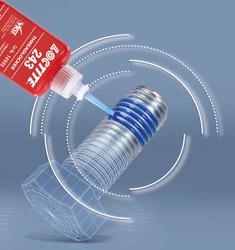
Posted to News on 10th Sep 2015, 17:19
Improve threaded fastener reliability with anaerobic adhesives
Andy Bardon, a Senior Application Engineer at Henkel Corporation, explains how the reliability of threaded fasteners can be improved by using anaerobic adhesives.

Threaded fasteners set and hold tolerances on assemblies ranging from light-duty equipment to heavy machinery. Loosening is one of the major causes of industrial equipment failure and results in millions of euros in unscheduled downtime costs each year. In many cases, fasteners that self-loosen during equipment operation may contribute to wear and fatigue, and result in poor operating tolerances, misalignment and, sometimes, catastrophic equipment failure. Various types of differential stresses - such as vibration and shock, thermal expansion and contraction, and micro-movement - reduce clamping force on the assembly and ultimately cause machine failure.
Proactive maintenance of threaded fasteners has helped to increase equipment uptime. Maintenance activities that counteract self-loosening come in two basic categories: mechanical locking devices and chemical machinery adhesives. Mechanical devices such as spring washers, wire retainers, and locking bolts are costly and cannot reliably prevent self-loosening caused by side-sliding motion. They also do not seal or prevent corrosion within the fastener assembly and must be sized appropriately for the specific fastener, resulting in large and costly parts inventories. The figure below, which compares vibration and clamp load, illustrates that many mechanical locking methods loosen over time, even when vibrations are minimal.

Liquid threadlocking adhesives have become one of the most reliable and inexpensive ways to ensure that a threaded assembly will remain locked and leakproof for its entire service life. Applied dropwise to fastener threads, liquid anaerobic products fill the voids in the threads and cure to a hard thermoset plastic when exposed to active metal ions in the absence of air. Machinery adhesives lock the threaded parts together, ensuring that mating parts will ultimately act as one conjoined part that resists failure and delivers the greatest possible reliability.
Dismantling threaded joints
Most assemblies held together by threaded fasteners will, at some time, be dismantled for repairs, maintenance or adjustment. For this purpose, threadlockers are available in low-strength formulations for easy removal, medium-strength grades that can be removed using common hand tools, and high-strength or 'permanent' grades suitable for very demanding assemblies with minimal service requirements. Even the highest-strength threadlockers can be removed with standard hand tools following direct exposure to temperatures of 230-260degC for about five minutes.
The viscosity of the threadlocker needed for an application is directly related to the size of the fastener used:
- Threads up to M12: products with a viscosity of at least 125mPa*s
- Threads up to M20: products with a viscosity of at least 500mPa*s
- Threads up to M36: products with a viscosity of at least 1000mPa*s
- Threads up to M80: products with a viscosity of at least 6000mPa*s
Low-viscosity penetrating threadlocking formulations are also available that easily wick into pre-assembled fasteners up to 6mm in diameter. For wicking into threads larger than 6mm, medium viscosity grades can be selected.
Threadlocker strength classes
The strength class of the threadlocker is selected to suit the thread length engaged, the thread size, the strength class of the bolt and the ease of disassembly. For a low-strength threadlocker the breakloose torque is lower than the on-torque. A medium-strength threadlocker has a breakloose torque similar or slightly higher than the the on-torque, and a high-strength threadlocker a much higher breakloose torque than the on-torque (tested on M10x35mm bolts, strength class 8.8, seated assembly, on-torque 49Nm).
Threadlocking adhesives should be applied only where the nut and bolt will meet when the assembly is fully tightened, as only adhesive between the threads will cure. A general hint is to apply the threadlocker onto the bolt thread in a distance of 1xnut height from the part. For blind-hole assemblies such as studs, threadlockers should be applied to the bolt and onto the threads within the blind hole. If adhesive is applied only to the bolt, air pressure may force the liquid to escape as the bolt is torqued down, and may result in incomplete cure and possible assembly failure.
The operating conditions of the end-use environment dictate the threadlocking formulation selected. The newest threadlocking technologies offer many advantages formerly unavailable, including surface-insensitive, high-temperature and chemically-resistant materials, as well as formulations engineered to withstand extreme vibration. Recent advances in the stability and reactivity of threadlocking materials have allowed the development of semi-solid 'stick' formulations that complement their liquid counterparts. Semi-solid threadlocking products work well in overhead or hard-to-see applications where liquids might be too messy or potential migration might be a problem.
More about anaerobic adhesives for threaded fasteners
Follow the link for more information about the Loctite Success Secured campaign; the microsite has customer case studies, videos, an adhesive selection 'wizard', webinars and a wealth of other useful information.
Want the latest machine building news straight to your inbox? Become a MachineBuilding member for free today >>

















